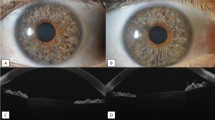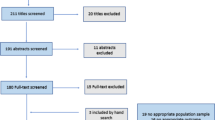Abstract
To describe the spectrum of contact lens-related problems in cases presenting to a tertiary referral eye hospital. A retrospective case record analysis of 111 eyes of 97 consecutive patients was undertaken over a period of five months at the Royal Victorian Eye and Ear Hospital, Melbourne, Australia. Contact lens-related complications (CLRC) were classified into microbial keratitis, sterile corneal infiltrates, corneal epitheliopathy and contact lens-related red eye (CLARE). Main parameters examined were nature of the first contact, clinical diagnosis, and management pattern. Forty-two percent of the initial presentations were to health care practitioners (HCPs) other than ophthalmologists. Mean duration from the onset of symptoms to presentation was 6.3 ± 10.9 days. Forty-nine percent (n = 54) of patients had an associated risk factor, most commonly overnight use of contact lenses (n = 14, 13 %). Most common diagnosis at presentation was corneal epitheliopathy (68 %) followed by sterile infiltrates (10 %), CLARE (8 %) and microbial keratitis (6 %). No significant differences were found in the pattern of treatment modalities administered by ophthalmologists and other HCPs. HCPs other than ophthalmologists are the first contact for contact lens-related problems in a significant proportion of patients. These HCPs manage the majority of CLRC by direct treatment or immediate referral.


Similar content being viewed by others
References
Suchecki JK, Donshik P, Ehlers WH (2003) Contact lens complications. Ophthalmol Clin North Am 16(3):471–484
Keay L, Edwards K, Stapleton F (2008) Referral pathways and management of contact lens-related microbial keratitis in Australia and New Zealand. Clin Exp Ophthalmol 36(3):209–216
Nilsson SE, Lindh H (1984) Daily contact lens wear: a three year follow-up. Acta Ophthalmol (Cph) 62(4):556–565
Efron N, Morgan PB, Hill EA, Raynor MK, Tullo AB (2005) Incidence and morbidity of hospital-presenting corneal infiltrative events associated with contact lens wear. Clin Exp Optom 88(4):232–239
Dart JK, Radford CF, Minassian D, Verma S, Stapleton F (2008) Risk factors for microbial keratitis with contemporary contact lenses: a case–control study. Ophthalmology 115(10):1647–1654
Radford CF, Minassian D, Dart JK, Stapleton F, Verma S (2009) Risk factors for nonulcerative contact lens complications in an ophthalmic accident and emergency department: a case–control study. Ophthalmology 116(3):385–392
Thebpatiphat N, Hammersmith KM, Rocha FN, Rapuano CJ, Ayres BD, Laibson PR, Eagle RC Jr, Cohen EJ (2007) Acanthamoeba keratitis: a parasite on the rise. Cornea 26(6):1–6
Foulks GN (2003) What is dry eye and what does it mean to the contact lens wearer? Eye Contact Lens 29(1):S96–S100 (discussion S115–S118, S192–S194)
Mucci JJ, Utz VM, Galor A, Feuer W, Jeng BH (2009) Recurrence rates of herpes simplex virus keratitis in contact lens and non-contact lens wearers. Eye Contact Lens 35(4):185–187
Rapkin JS (1988) The effect of daily wear time on contact lens complications. CLAO J 14(3):139–142
Vajpayee RB, Dada T, Saxena R, Vajpayee M, Taylor HR, Venkatesh P, Sharma N (2000) Study of the first contact management profile of cases of infectious keratitis: a hospital-based study. Cornea 19(1):52–56
Britt H, Miller G, Charles J, Pan Y, Valenti L, Henderson J, Bayram C, O’Halloran J, Knox S (2007) General practice activity in Australia 2005–06. General practice series No. 19, AIHW cat. no. GEP 19. Australian Institute of Health and Welfare, Canberra
Melia B, Islam T, Madgula I, Youngs E (2008) Contact lens referrals to hull royal infirmary ophthalmic A&E unit. Contact Lens Anterior Eye 31(4):195–199
Keay L, Edwards K, Naduvilath T, Forde K, Stapleton F (2006) Factors affecting the morbidity of contact lens-related microbial keratitis: a population study. Invest Ophthalmol Vis Sci 47(10):4302–4308
Stapleton F, Keay L, Edwards K, Naduvilath T, Dart J, Brian G, Holden B (2008) The incidence of contact lens–related microbial keratitis in Australia. Ophthalmology 115(10):1655–1662
Keay L, Edwards K, Stapleton F (2009) Signs, symptoms, and comorbidities in contact lens-related microbial keratitis. Optom Vis Sci 86(7):803–809
Conflict of interest
None of the authors have any financial/conflicting interests to disclose.
Author information
Authors and Affiliations
Corresponding author
Rights and permissions
About this article
Cite this article
Fagan, X.J., Jhanji, V., Constantinou, M. et al. First contact diagnosis and management of contact lens-related complications. Int Ophthalmol 32, 321–327 (2012). https://doi.org/10.1007/s10792-012-9563-z
Received:
Accepted:
Published:
Issue Date:
DOI: https://doi.org/10.1007/s10792-012-9563-z




